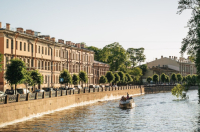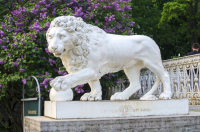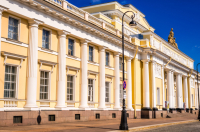Gavan
Vasilyevsky Island, which for centuries served as St. Pete's main harbor, has naturally gone all-in on marine-centric motifs. For one, the flag of one of its municipal districts, Gavan (meaning “harbor” in Russian), is greatly influenced by Greek and Roman mythology; it depicts a half-horse, half-fish creature, aka the hippocampus, and a trident-shaped key. Another “hero” on the flag is one of the guard towers known as Kronshpitsy, which flank the harbor’s entrance and are the only remaining structures from the district's original 18th-century ensemble. All these elements symbolize the district’s location and connection with the sea.
Shuvalovo-Ozerki

Credit: Анастасия Гошовская / Wikimedia Commons
The Shuvalovo-Ozerki district’s flag features another mythical creature, namely a unicorn. In heraldic tradition, the unicorn is rather a symbol of strength and courage than magic; it comes from the coat of arms of the Shuvalovs, a Russian aristocratic family that once owned the land of Shuvalovo. Remarkably, their unicorns had also grown to serve as the name of a Russian cannon that had been in use for almost a century. And as for the three striped circles, these are in fact the three Suzdal Lakes: Upper, Middle, and Lower.
Zvezdnoe

Credit: Own work / Wikimedia Commons
The flag of Zvezdnoe also makes clear references to the district's history. The flag features five dark-blue stars at the top that correspond to the five historic areas that make up the district – and also serve as a lovely play on the district’s name, Zvezdnoe, which means “starry” in Russian. The two bulls represent a pair of statues that until recently have stood at the entrance to the local meat plant and the frog refers to the former name of one of its constituent areas, literally translated as Frog’s Lake.
Lomonosov

Credit: Lomonosov’s municipal authorities / Wikimedia Commons
Lomonosov’s flag design is quite simple and direct; the orange tree on the flag alludes to the city’s former name Oranienbaum (up to 1948), which is translated as “orange tree” from German. As the legend has it, the city got its name from oranges that grew in the local palace's greenhouses. Later on, in 1948, the city was renamed after the scientist and writer Mikhail Lomonosov – but its symbols remained untouched.
Shushary

Credit: Wikimedia Commons
Though this town’s flag is sure to stand out for its color alone, there's much more to it. In fact, its flag recaps the most significant milestones in the history of the territory: its ties to Finland (the white symbol in the middle stems from Izhorian embroidery), agriculture and peatlands (the sickle and the sheaf of grain), as well as the Tsarskoye Selo Railway (Russia’s first railway!), which runs through the town (the white converging lines).
Give this story a read if you wish to learn more about Russia’s heraldics and the rare animals you can find on emblems of its many cities and regions.




